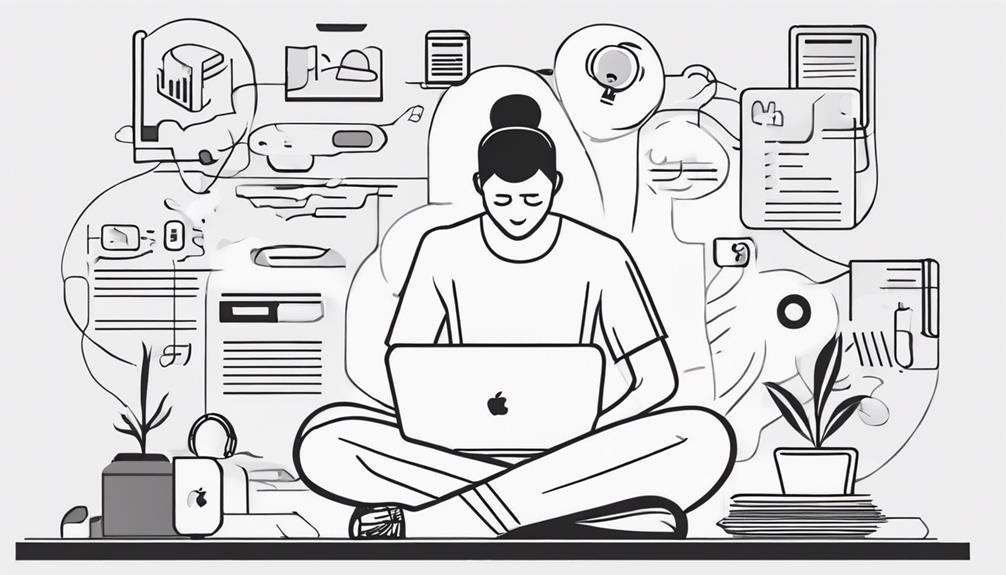Tiny habits can completely transform your life. By focusing on small, manageable changes, you can create significant improvements over time. It's all about the habit loop: identify a cue, perform a routine, and enjoy a reward. When you celebrate these small wins, you boost your motivation and reinforce positive behaviors. Start with simple tasks, like drinking a glass of water each morning or doing one push-up. These tiny actions fit seamlessly into your day and keep you on track. As you develop these habits, you'll find that bigger changes follow suit, opening the door to even more opportunities.
Key Takeaways
- Tiny habits create sustainable change by integrating small, manageable actions into daily routines, promoting consistency and ease of execution.
- The habit loop of cue, routine, and reward helps establish automatic behaviors, making it easier to form new habits over time.
- Celebrating small victories enhances motivation, reinforcing positive behaviors and building confidence towards achieving larger goals.
- Behavior change is driven by motivation, ability, and prompts, with the Tiny Habits Method facilitating manageable actions for lasting transformation.
Understanding Human Behavior
Understanding human behavior requires recognizing the dynamic interplay between your biological makeup and the environmental influences surrounding you.
Your habits stem from both genetic predispositions and the contexts you navigate daily.
Motivation is essential here; whether it's driven by intrinsic desires or external rewards, it fuels your commitment to develop new habits.
The habit loop—comprising a cue, routine, and reward—illustrates how consistent actions transform into automatic behaviors, allowing you to perform tasks with less conscious effort.
The Science of Habit Formation

Understanding how habits form is key to making lasting changes in your life.
You'll find that the habit loop—comprising a cue, routine, and reward—plays a crucial role in automating your behaviors, while motivation and rewards help keep you on track.
Habit Loop Mechanics
At the heart of habit formation lies the habit loop, which consists of a cue, routine, and reward that work together to create lasting behavioral change. When you identify a cue, you can trigger a specific routine that ultimately leads to a reward, reinforcing the habit over time. This process is supported by the formation of new neural pathways in your brain, making these behaviors more automatic.
Here's a breakdown of the habit loop mechanics:
| Component | Description |
|---|---|
| Cue | The trigger that initiates the routine. |
| Routine | The action you take in response to the cue. |
| Reward | The benefit you receive after completing the routine. |
Consistent repetition of these elements strengthens your motivation and helps in personal goal achievement. By understanding and modifying your habit loop, you can create effective routines that align with your goals. This approach not only enhances habit formation but also makes the process of change more manageable and sustainable. So, next time you want to change a habit, consider how you can adjust your cues, routines, and rewards for better results!
Motivation and Reward Systems
Motivation drives your ability to form and sustain habits, as both intrinsic desires and external rewards fuel your commitment to new behaviors. To effectively create lasting habits, focus on small changes that are easier to incorporate into your daily routine.
The Fogg Behavior Model suggests that starting with tiny habits increases your chances of success, making the process feel less overwhelming. As you engage in new behaviors, remember the importance of the habit loop: cue, routine, and reward.
Celebrating small wins along the way releases dopamine, which enhances your motivation and reinforces the positive behaviors linked to those rewards. By tracking your progress and rewarding yourself for completing habits, you create a powerful reinforcement system that encourages continued effort.
Incorporating positive reinforcement techniques not only helps sustain your motivation but also solidifies the connection between your behavior and the rewards you receive. This cycle of motivation and reward will ultimately lead to significant changes, as small, consistent actions compound over time, resulting in lasting success.
Principles of Behavior Change

Behavior change thrives on simple, actionable steps that you can easily integrate into your daily routine. The Fogg Behavior Model emphasizes that successful behavior change relies on three key components: motivation, ability, and prompts. By focusing on tiny habits, you can simplify these actions, making it easier to execute them consistently.
Cultivating discipline through these tiny habits can serve as a vital foundation for building resilience, as resilience is a skill that develops through facing challenges with strength and fortitude.
When you celebrate small wins after completing your tiny habits, you reinforce positive emotions that boost your motivation and commitment to future actions. This emotional connection helps to solidify these behaviors in your daily life.
Additionally, habit stacking can be a powerful strategy for integrating new habits seamlessly. By linking a new habit to an existing routine, you create a natural prompt that encourages you to follow through.
Consistency is essential; research shows that practicing tiny habits regularly leads to the formation of new neural pathways, making these actions more automatic over time.
As you develop your ability to perform these small behaviors, you'll find that they create a foundation for larger changes. By understanding and applying these principles, you can set yourself up for lasting behavior change without feeling overwhelmed.
The Tiny Habits Method

The Tiny Habits Method, crafted by Dr. BJ Fogg, helps you kickstart lasting change by focusing on small, manageable actions that fit seamlessly into your daily life. This approach emphasizes establishing tiny habits to promote sustainable behavior change without overwhelming yourself.
You begin by selecting a tiny habit that aligns with your goals and identifying an anchor routine to remind you when to practice it. As you engage in this daily practice, you'll notice a gradual increase in your ability to perform the habit.
Each time you successfully follow through, it's essential to celebrate success, reinforcing positive feelings and motivation. This celebration triggers dopamine release, making you more likely to continue your progress.
Fogg's five-step process also encourages making adjustments as needed, ensuring that your tiny habits remain practical strategies that work for you. Over time, these small actions can create a habit that feels automatic, leading to significant transformations in your behavior.
Applying Tiny Habits in Daily Life

Integrating tiny habits into your daily life can transform your routines and help you achieve your goals with ease. By focusing on small changes, you'll create sustainable habits that fit seamlessly into your existing daily routines. Start with microsteps—like drinking a glass of water every morning or doing one push-up after brushing your teeth.
Here's a quick guide to get you started:
| Tiny Habit | Celebration |
|---|---|
| Drink a glass of water | Smile and say, "Good job!" |
| Read one page of a book | Share with a friend |
| Take a short walk | Give yourself a thumbs-up |
| Write one sentence | Jot it down in a journal |
As you implement these tiny habits, don't forget to celebrate small wins. This reinforces positive behavior and paves the way for significant improvements over time. You'll notice enhanced productivity and an increase in overall life satisfaction as these tiny habits take root. Remember, achieving bigger goals doesn't have to be intimidating; it's all about taking those small, manageable steps.
Overcoming Challenges in Habit Formation

When you're trying to form new habits, identifying triggers and obstacles is key to overcoming challenges.
Incorporating practical techniques for overcoming personal challenges can greatly enhance your habit formation journey.
By recognizing what holds you back, you can create strategies to celebrate small victories along the way.
This process not only keeps you motivated but also builds a stronger foundation for lasting change.
Identifying Triggers and Obstacles
Identifying triggers plays an essential role in overcoming challenges during habit formation, as recognizing cues that lead to unwanted behaviors allows you to develop effective strategies for positive change.
You may face common obstacles like unrealistic expectations and overwhelming goals, which can derail your efforts. In fact, studies show that 92% of New Year's resolutions fail, often due to these factors.
To combat this, break down your goals into small, actionable microsteps. This approach makes the process feel more manageable and increases your chances of success.
As you work through these microsteps, tracking progress is vital. Use visual methods or enlist an accountability partner to keep you motivated and committed.
Celebrating Small Victories
Recognizing and celebrating small victories can greatly enhance your motivation and commitment as you navigate the challenges of forming new habits. Each time you acknowledge progress, even in tiny increments, you build a mindset that embraces continuous improvement. This approach helps you focus on manageable, progressive steps rather than overwhelming goals.
| Celebration Type | Example | Effectiveness |
|---|---|---|
| Verbal Affirmation | "I did great today!" | Boosts self-confidence |
| Small Reward | Treat yourself | Reinforces positive behavior |
| Sharing with Friends | Post on social media | Builds a supportive network |
Long-Term Impact of Tiny Habits

Tiny habits can create lasting change in your life by building momentum towards your larger goals through consistent, manageable actions. When you focus on tiny habits, you tap into the cumulative effect of small changes that reinforce your behavior over time. Simple adjustments in your daily routine, such as organizing your cleaning schedule to include a quick best value vacuum cleaner session, can lead to a tidier home and a clearer mind.
Research shows that starting small increases your chances to maintain habits, especially considering that 92% of people struggle with New Year's resolutions due to overwhelming expectations.
To guarantee long-term success, integrate these tiny habits into your daily routines and continuously reinforce them with rewards. This strategy enhances your motivation and boosts self-awareness, making it easier to stick with your new behaviors. Remember to celebrate small victories along the way; this positive reinforcement helps create lasting associations with your habits, increasing the likelihood they'll become second nature.
As you nurture these tiny habits, you'll find they pave the way for more ambitious goals. Over time, this progress leads to improved overall life satisfaction and well-being. So, embrace the power of tiny habits, and watch as they transform your life, one small step at a time.
Frequently Asked Questions
Why Small Habits Can Make a Big Difference?
Small habits can make a big difference because they're manageable and less overwhelming. When you consistently practice them, you build momentum, boost your confidence, and create lasting change that transforms your daily life positively.
What Is the Power of Tiny Habits?
Did you know that people who make tiny changes are 90% more likely to stick with their goals? Tiny habits boost motivation, build momentum, and create lasting change, making it easier for you to achieve your dreams.
What Is the Power of Tiny Changes?
The power of tiny changes lies in their ability to create momentum. By starting small, you can easily integrate new habits into your life, boosting motivation and leading to significant transformations over time without feeling overwhelmed.
What Is the Power of Little Habits?
Imagine planting a seed; little habits act like water and sunlight, nurturing growth. They build momentum, spark motivation, and create lasting change. Embrace these tiny actions, and you'll discover their powerful impact on your life.
How Do Tiny Habits and Micro-Improvements Lead to Personal Growth and Change?
Implementing microimprovements for personal growth can lead to significant changes over time. By making small, consistent changes to our habits and behaviors, we can create a snowball effect of progress. These tiny habits, when practiced regularly, can ultimately lead to substantial personal growth and positive change in our lives.
Conclusion
Incorporating tiny habits into your daily routine can lead to remarkable transformations over time.
Did you know that research shows people who make small, incremental changes are 10 times more likely to stick to their goals?
By focusing on these manageable actions, you're setting yourself up for success.
Embrace the power of small things, and watch how they snowball into significant improvements in your life.
You've got the tools—now it's time to take that first step!










